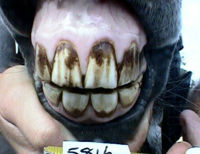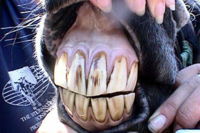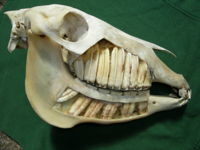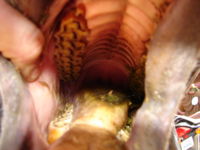Normal Teeth - Donkey
Evolution and tooth physiology




Since donkeys evolved as browsers in often harsh, arid environments, it would be expected that their teeth would be sufficiently hard to resist the likely increased rate of dental attrition caused by the high levels of silicates
and phytoliths (sand-like particles) on the herbage they had to survive on. There is anecdotal evidence that the ‘floating’ (rasping) of donkey dental overgrowths is more difficult than for horses. However, studies have yet to be made to confirm these suspicions. Micro-hardness of horse dental tissue has been assessed in Thoroughbred, draught and Arab breeds, with the Arab breed having significantly harder teeth.
Ageing
A study of 63 donkeys of known age found eruption times of deciduous and permanent incisors to be later than for horses, and the appearance of the dental star on permanent incisors to be earlier than horses. Other authors have reported that corner incisors will often not come fully into wear until nine to ten years of age, and that the occlusal surface of upper incisors with a ‘seagull wing’ or ‘smile’ appearance that are present when donkeys reach their early teens may still be present when donkeys are over 20 years of age. Galvayne’s groove, dental hooks and length of clinical crown were all found to be unreliable measures for estimating age in donkeys.
References
- Dacre, I., Dixon, P. and Gosden, L. (2008) Dental problems In Svendsen, E.D., Duncan, J. and Hadrill, D. (2008) The Professional Handbook of the Donkey, 4th edition, Whittet Books, Chapter 5
Fact Sheet
Donkey Dental Care for Vets and Equine Dental Technicians
Literature Search
Use these links to find recent scientific publications via CAB Abstracts (log in required unless accessing from a subscribing organisation).
Dental anatomy/structure/development in donkeys publications
|
|
This section was sponsored and content provided by THE DONKEY SANCTUARY |
|---|
